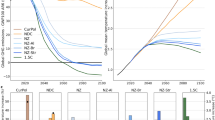Abstract
The first Conference of the Parties to the UN Framework Convention on Climate Change opened the path for a new policy instrument to mitigate anthropogenic climate change. It instituted a pilot phase for international emission offsets, “Joint Implementation”, open for all signatories to the Convention. During the pilot phase, however, emission reductions achieved abroad cannot be credited to domestic emission targets. By 2000, a decision on crediting and the final structure of the Joint Implementation regime must be taken by the Conference of the Parties.
Similar content being viewed by others
|o
Cf. M. Grubb, A. Rose: Introduction: nature of the issue and policy implications, in: UNCTAD (ed.): Combating global warming, New York 1992, p. 3.
Cf. A. Michaelowa: Joint Implementation of greenhouse gas reductions under consideration of fiscal and regulatory incentives, HWWA-Report No. 153, Hamburg 1995, pp. 7–12.
Cf. e.g. Federation of German Industries: Changing course with eco-taxes?, Cologne 1994.
Cf. P. Sorsa: Competitiveness and environmental standards: some exploratory results, World Bank Policy Research Working Paper No. 1249, Washington 1994.
See e.g. INC: Matters relating to commitments—criteria for Joint Implementation, Comments from Parties or other member states, A/AC.237/Misc. 37, Geneva 1994; INC: Matters relating to commitments—criteria for Joint Implementation, in: Kilaparti Ramakrishna (ed.): Criteria for Joint Implementation under the Framework Convention on Climate Change, Woods Hole Research Center, pp. 51–58, 1994; INC: Matters relating to commitments—criteria for Joint Implementation, Comments from member states on criteria for Joint Implementation, A/AC.237/Misc.33 and Add., Geneva 1993.
Cf. N. Dubash: Commoditizing carbon: Social and environmental implications of trading carbon emissions entilements, Master’s Thesis, Berkeley 1994.
For a description of ongoing Joint Implementation projects see Joint Implementation Quarterly, No. 1, 1995.
See Face Foundation: Face Foundation in practice, Arnhem 1995; Face Foundation: 1994 annual report, Arnhem 1995.
Cf. Climate Network Europe: Joint Implementation from a European NGO perspective, Brussels 1994.
Cf. Werner Katscher, Gotthard Stein, John Lanchbery, Julian Salt (eds.): Greenhouse gas verification-Why, how and how much?, proceedings of a workshop, Bonn, April 28–29, Jülich 1994.
For the calculation of the global warming potentials see J. S. Fuglestvedt et al.: Direct and indirect global warming potentials of source gases, CICERO Report 1994–1, Oslo 1994.
For the calculation see A. Michaelowa, op. cit,, Joint Implementation of greenhouse gas reduction uunder consideration of fiscal and regulatory incentives, HWWA-Report No. 153, Hamburg 1995, pp. 66f.
For general rules for the calculation of tax concessions for different projects see A. Michaelowa, op. cit., Joint Implementation of greenhouse gas reductions under consideration of fiscal and regulatory incentives, HWWA-Report No. 153, Hamburg 1995, pp. 78–82.
Cf. New York State Energy Office: Draft New York State energy Plan, New York 1994, pp. 147–177.
For verification issues see Katscher et al., op. cit. (eds.) Greenhouse gas verification-Why, how and how much?, proceedings of a workshop, Bonn, April 28–29, Jülich 1994.
Author information
Authors and Affiliations
Rights and permissions
About this article
Cite this article
Michaelowa, A. Joint implementation: a promising instrument for climate protection. Intereconomics 30, 163–171 (1995). https://doi.org/10.1007/BF02928087
Issue Date:
DOI: https://doi.org/10.1007/BF02928087




